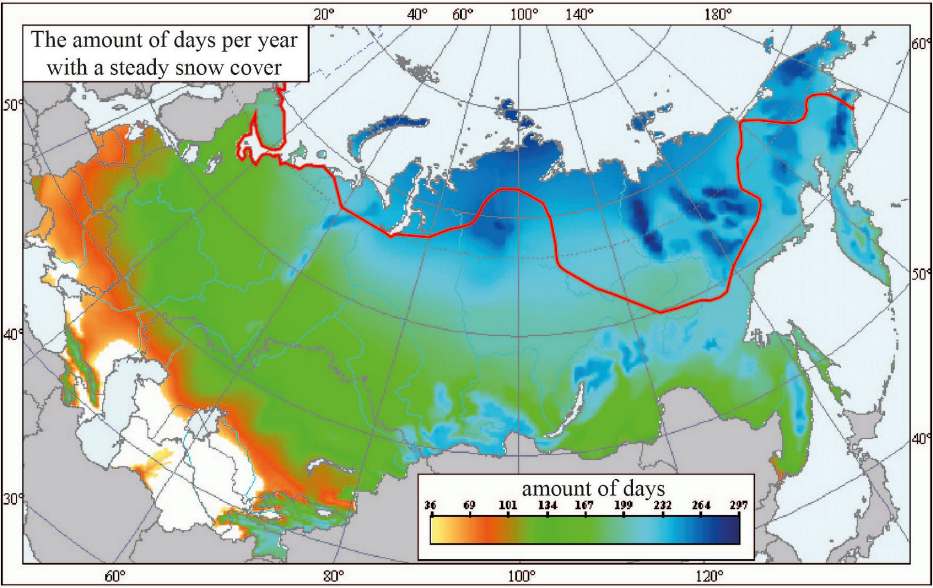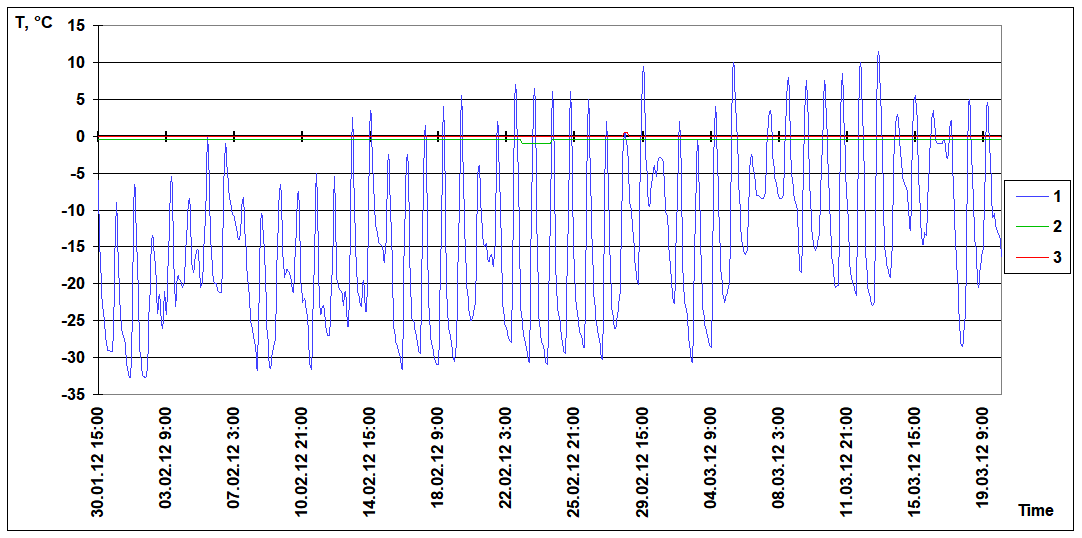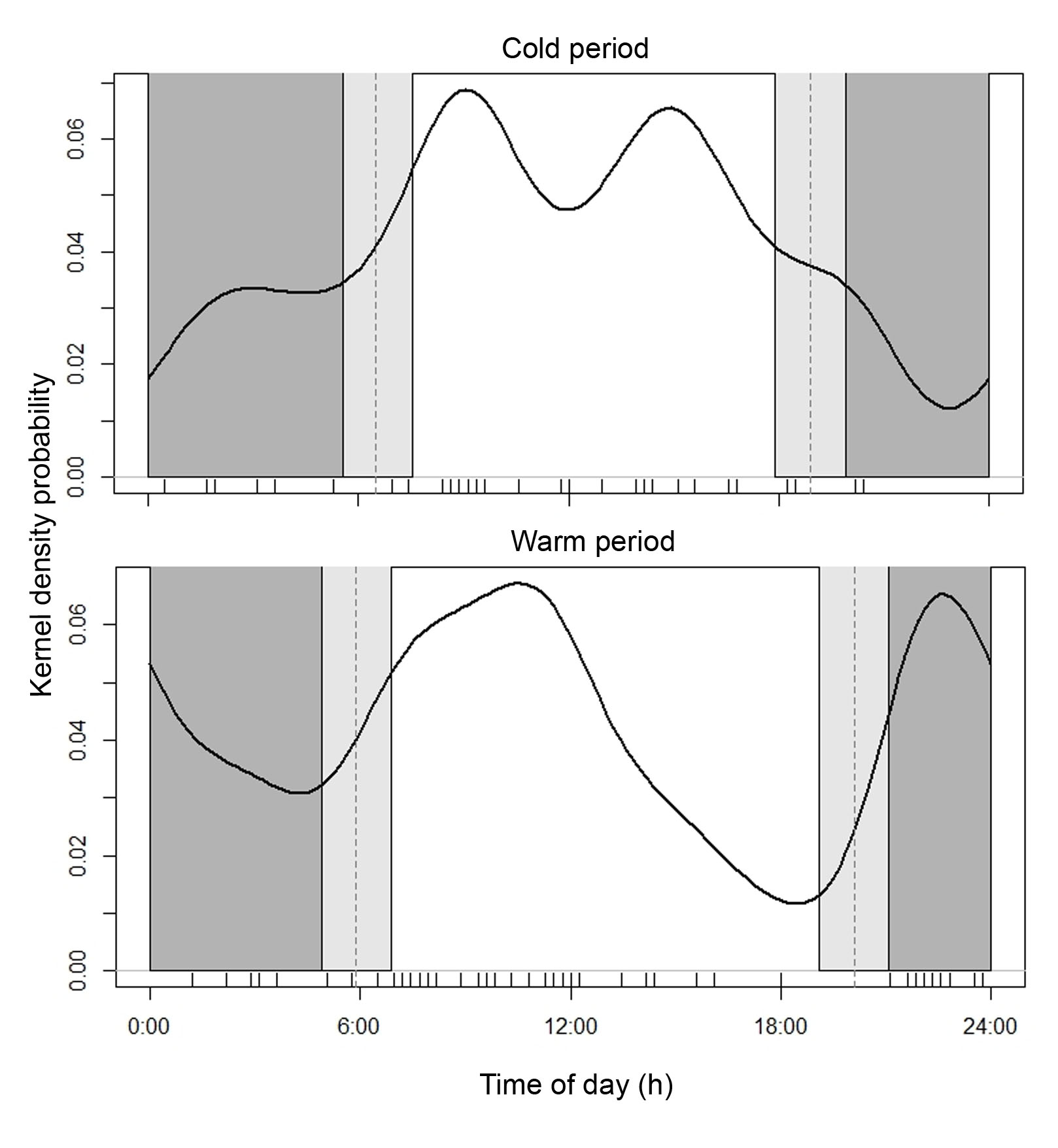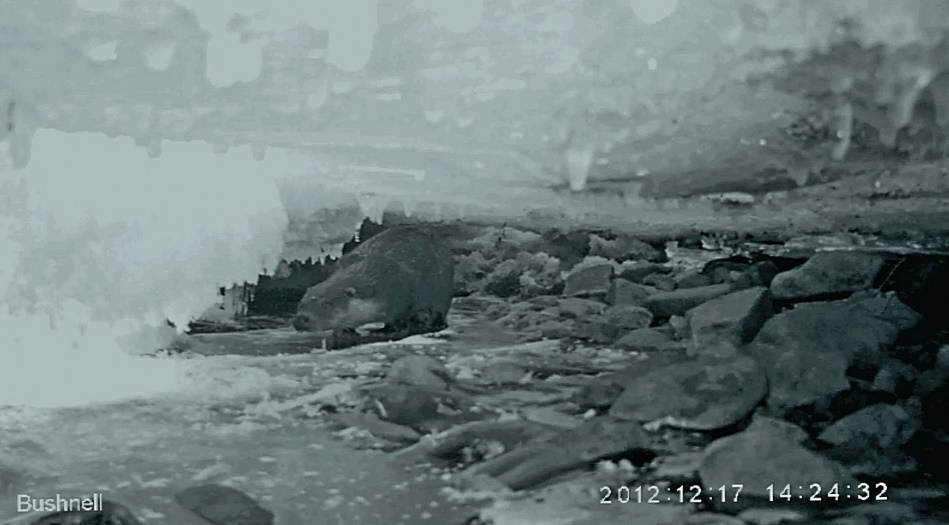IUCN/SSC Otter Specialist Group Bulletin

©IUCN/SCC Otter Specialist Group
Volume 36(A) Special Issue (April 2019)
 PROCEEDINGS OF THE 14th INTERNATIONAL OTTER CONGRESS
PROCEEDINGS OF THE 14th INTERNATIONAL OTTER CONGRESS
8 - 19th April 2019
Tangjiahe, China
Behavioral Adaptations of Eurasian Otter (Lutra lutra) to Winter Conditions of Northern Latitudes
Aleksey Yu. Oleynikov1
1Laboratory of Ecology Animals Institute of Water and Ecological Problems Far East Branch Russian Academy of Sciences, Khabarovsk 680000, Dikopolceva St., Russia. e-mail: shivki@yandex.ru
Received 2nd August 2019, accepted 25th November 2019
Abstract: The study of behavioral responses of otter to life in northern latitudes was carried out in the Far East of Russia in 2011-2018. We carried out a comparative measurement of atmospheric air temperature, the temperature in under-ice hollows and water temperature in the cold period of the year using DS1921 thermochrons. We have observed the daily activity of the otter in winter and tracing along the tracks in the snow. The otter’s behavioral traits used daily fluctuations in air temperature and subglacial voids with a favorable microclimate to help the otter live the harsh conditions of northern latitudes.Keywords: Eurasian otter, Lutra lutra, thermochrons, under-ice hollows, harsh climatic conditions
INTRODUCTION
Eurasian otter (Lutra lutra) is a widespread semiaquatic predator with flexible behavior. About 1/5 of its range is located in areas with harsh climatic conditions. In the north of Eurasia, the duration of the period with a steady snow cover can exceed 250 days, and temperatures drop to -68 °C (Oymyakon, Yakutia, Russia) (Figure 1). What allows the species to survive in harsh climatic conditions and live north of the polar circle? Undoubtedly, it is a complex of morpho-anatomical, physiological and behavioral adaptations to the harsh environmental conditions (Formozov, 1946; Marchand, 2014; Blix, 2016). The physiological and morpho-anatomical adaptations of the otter to the reduction of heat losses are known: the shape and size of the body, fur cover (structure of hairs), and fat storage (Tarasoff, 1974; Estes, 1989; Weisel et al., 2005). Less is known about the otter's behavioral responses that include mobility. An otter is well adapted to walking in deep snow and under the ice. The otter has a flexible pattern of daily activity that helps it maintain thermoregulation (Kruuk, 2006; Quaglietta et al., 2018).

The aim of the study was to find out what behavioral adaptations allow an otter to live in winter conditions of northern latitudes. I planned to test the following hypothesis: the use of under-ice and under-snow hollows with specific microclimate and a shift in daily activity helps the Eurasian otter to survive in harsh climatic conditions.
MATERIALS AND METHODS
The studies were carried out in various regions of the Far East of Russia with a harsh climate (Khabarovsky Krai, Sakhalin Oblast) from 2011 to 2018 years. The total field effort in the cold season was more than 240 days. 65 medium and small rivers (watercourses) were examined. The length of the routes was about 1200 km of the coastline of the watercourses.
In the cold period of the year, we used snow tracking (followed the tracks in the snow with a total distance 35 km), visual observations (109 registrations) and automatic recording (Bushnell Trophy Cam 119636C, 80 registration records) of daily activity. We installed camera traps along river banks at the otter marking latrines. A total of 1,450 camera days were worked out. Each day was divided into three periods: daytime, nighttime and twilight. The duration of these periods were determined by the time of sunrise and sunset for each date that were calculated for the geographic coordinates of the Khabarovsky Krai (48º28′N, 135º3′E, GMT +10) using the website www.sunrisesunset.com. We used four intervals: morning twilight (time 1 h before and after sunrise), daytime (time between the end of the morning twilight and the start of the evening twilight), evening twilight (time 1 h before and after sunset) and night (time between the end of the evening twilight and the start of the morning twilight) (Romero-Muñoz et al., 2010; Ikeda et al., 2016).
Seasons were divided on two periods according to climatic data, and were determined by average temperatures for each period. Average dates for seasons were as follow: for cold season – 16.10 - 16.03; warm season – 17.03 - 15.10.
Like in many other similar studies we used the approach developed by Ridout and Linkie (2009) to estimate the activity patterns of the otter using kernel density analysis (Foster et al., 2013; Ikeda et al., 2016; Rheingantz et al., 2016). All these procedures were implemented in R 3.3.1 software (R Development Core Team, 2015) with the «camtrapR» (Niedballa et al., 2016).
To study the microclimate of under-ice hollows used by the otter, we installed thermochrons (Thermochron iButton ™ model DS1921) recorded temperature range -40 + 85°С; measurement error ± 1°С; minimum gradation measuring 0.5 °С (https://www.ibuttonlink.com). We made an ice-hole in the river for the installation of thermochrons. They were mounted on a pole in plastic containers at the appropriate height. The ice-hole was filled with ice and then snow to a natural level. Thermochrons were installed in the winter seasons of 2010 - 2012. In the first season (2010/2011) we could not obtain the objective data as the devices were flooded with aufeis.
Figure 2 shows the layout of thermochrons for studying the temperature regime of under-ice hollows. The temperature of the water was measured, in the empty air and surface air every four hours from December to March (installation period 30.01.2012-21.03.2012. 51 days) on Mul̕pa River Russia, Khabarovsky Krai, Sovetsko-Gavansky District, Botchinsky Reserve geographical coordinate’s N 48˚17'28'', E 139˚36'26''.
RESULTS
By snow-tracking at the field station (Middle Sikhote-Alin Mountain), it was established that an otter in winter passes 76% of its way under the ice while moving along its habitat. The use of an otter for the winter life of under-ice hollows is confirmed by the recordings made by a camera-trap (Figure 3), as well as by the presence of long-term otter latrines here.
Despite significant temperature changes even within one day (from -30 to 6 °C) the temperature under the ice fluctuated slightly -0.5-1 °C. The water temperature at the surface was about 0 +0.5 °C (Figure 4). Thus, the temperature in the under-ice hollows remained constant with minimal fluctuations, which was a favorable factor for the life of the otter during the unfavorable climatic (temperature) period of the year.

Observations of the daily activity of the otter using camera traps show that in the cold period of the year, the peak of activity during the day; in the warm period of the year, the activity is shifted by the first half of the day and night (Figure 5).

DISCUSSION
Snow cover is the major factor for maintaining a constant temperature in under-ice hollows and, to a lesser extent, ice, the thermal conductivity of which is much higher (Formosov, 1969; Marchand, 2014). Thermal conductivities of fresh snow is 0.0003 W/cm/°K, for ice (0 °C) 0.021 W/cm/°K (Marchand, 2014).
Many rivers of Northern Eurasia are covered with ice at elevated water levels, in winter the water subsides, and extensive under-ice hollows are formed. Numerous hollows, ice leads (space of open water among ice) and non-freezing springs provide semi-aquatic mammals with free access to water and safety. They are used by otter for safe movement in search of food and as shelters.
In December-January, with the establishment of deep snow cover and a decrease in temperature to -25-35 °С, the otter leads mainly to the under-ice life. Some individuals may not leave the shelters for a long time (Danilov and Tumanov, 1976; our data) or move exclusively under the ice in hollows with a favorable microclimate. The under-ice hollows provide predators with access to water; serve as protection against enemies and adverse weather conditions.
Researchers discussed the flexibility of otters in changing daily activity, in particular the differences in otters’ activity on mainland rivers and on the seashore (Kruuk, 2006), in areas with hot and arid climate conditions (Quaglietta et al., 2018). However, no data on the daily activity of otters in northern latitudes have been provided.
In the cold period, the daily activity of the otter grows in the morning twilight and is high from 9 to 17 hours, when the atmospheric (surface) air warms to the maximum, then decreases in the evening twilight and remains low during the night. In the warm period, the otter activity rises in the morning to 11, then drops sharply and begins to rise again in the evening twilight (Figure 5). Night-time otter activity in winter is lower than in summer. Thus, animals avoid extremely low and high temperatures. I consider that the seasonal change in daily activity allows the otter to better maintain thermoregulation.
In the northern regions, otters live in winter, as a rule, in stream with flowing water, since lakes, oxbows completely freeze (there is no access to water), the seacoast is also not everywhere available due to the formation of ice. In winter, access to water is a limiting factor. Otters are forced to leave wide areas with unfavorable ice cover (there are no empty lands; no access to water, and aufeis is developed). Otters have a lot of shelters that are used when moving around the home ranges, maintaining a high level of mobility, but to place with concentration of forage and favorable microclimatic conditions they can live for a long time in a very limited part of the stream. Due to their mobility, otters move around the site and develop available foraging spots.
The otter’s population density in the north is low, because there are few areas of water bodies with favorable winter conditions (Dubinin, 2002; pers. observation). Even in spite of this, in harsh conditions complex social groups of animals could appear temporarily, and that confirms the flexibility of the otters’ behavior. The Eurasian otter is predominantly a solitary animal, although home ranges of adult male and female overlap (Kruuk, 2006).
When water freezes, in some parts of the rivers aufeis appears and it becomes completely unsuitable for otter to survive. Aufeis can overspread (flood) the entire river valley and stretch for dozens of kilometers. There is no access to water, no hollows, everything freezes. And otters are forced to concentrate in favorable places. I repeatedly observed the snow tracks of 5-6 individuals of different sex and age using one ice hollow. They used the same trails and I did not find any cases of intraspecific aggression. It also confirms the flexibility in the behavior of the otter.
CONCLUSIONS
Otter behavior adaptation is important for mitigation winter stress in a professional (specialized) ecological niche. Even at very low ambient temperatures, under-ice habitat reduces energy costs and survives the studied group of animals in northern latitudes, up to and including the tundra zone. Otters also shifted their activity to a warmer period of day. Thus, they reduce heat loss.
REFERENCES
Blix, A.S. (2016). Adaptations to polar life in mammals and birds. Journal of Experimental Biology 219(8): 1093-1105.
Danilov, P.I., Tumanov, I.L. (1976). Marten of the Northwest the USSR. Science, Leningrad, USSR. 256p. [in Russian].
Dubinin, E. A. (2002). River Otter (Lutra lutra L.) in northeastern Siberia: Distribution and numbers. Russian Journal of Ecology, 33(3), 220-223.
Estes, J.A. (1989). Adaptations for aquatic living by carnivores. In: Gittleman, J.L. (Ed.) Carnivore behavior, ecology, and evolution. Springer, Boston, MA, pp. 242-282.
Formozov, A.N. (1946). Snow cover as an integral factor of the environment and its importance in the ecology of mammals and birds. Fauna and Flora of the USSR. New Ser. Zool. 5: 1-152.
Foster, V.C., Sarmento, P., Sollmann, R., Tôrres, N., Jácomo, A.T., Negrões, N., Silveira, L. (2013). Jaguar and puma activity patterns and predator‐prey interactions in four Brazilian biomes. Biotropica, 45(3), 373-379.
Ikeda, T., Uchida, K., Matsuura, Y., Takahashi, H., Yoshida, T., Kaji, K., Koizumi, I. (2016). Seasonal and diel activity patterns of eight sympatric mammals in Northern Japan revealed by an intensive camera-trap survey. PLoS ONE 11(10): e0163602.
Kruuk, H. (2006). Otters: ecology, behavior and conservation. Oxford University Press, New York. 265 pp.
Marchand, P.J. (2014). Life in the cold: an introduction to winter ecology. UPNE. 320p.
Niedballa, J., Courtiol, A., Sollmann, R., Mathai, J., Wong, S.T., Nguyen, A.T.T., Mohamed, A., Tilker, A., Wilting, A. (2016). Camera trap data management and preparation of occupancy and spatial capture-recapture analyses. R package version 0.99.9. Available from: https://cran.r-project.org/package=camtrapR
Quaglietta, L., Mira, A., Boitani, L. (2018). Extrinsic and intrinsic factors affecting the daily rhythms of a semiaquatic carnivore in a Mediterranean environment. Hystrix, the Italian Journal of Mammalogy, 29(1), 128-136.
Rheingantz, M.L., Leuchtenberger, C., Zucco, C.A., Fernandez, F.A. (2016). Differences in activity patterns of the Neotropical otter Lontra longicaudis between rivers of two Brazilian ecoregions. Journal of Tropical Ecology, 32(2), 170-174.
Ridout, M.S., Linkie, M. (2009). Estimating overlap of daily activity patterns from camera trap data. Journal of Agricultural, Biological, and Environmental Statistics, 14(3): 322-337.
Romero-Muñoz, A., Maffei, L., Cuéllar, E., Noss, A.J. (2010). Temporal separation between jaguar and puma in the dry forests of southern Bolivia. Journal of Tropical Ecology, 26(3): 303-311.
Tarasoff, F.J. (1974). Anatomical adaptations in the River otter, sea otter and harp seal with reference to thermal regulation. In: Harrison, R.J. (Ed.) Functional anatomy of marine mammals 2. Academic Press, London, pp. 111-141.
Weisel, J.W., Nagaswami, C., Peterson, R.O. (2005). River otter hair structure facilitates interlocking to impede penetration of water and allow trapping of air. Canadian Journal of Zoology 83(5): 649-655.
Resumé: Adaptations Comportementales De La Loutre Eurasienne (Lutra Lutra) Aux Conditions Hivernales Des Latitudes Nord
L’étude des réponses comportementales de la loutre à la vie sous les latitudes Nord a été réalisée dans l’Extrême-Orient de la Russie entre 2011 et 2018. Nous avons effectué une mesure comparative de la température de l’air atmosphérique, de la température dans les creux sous la glace et de la température de l’eau pendant la période froide de l’année en utilisant des thermochrons DS1921. Nous avons observé l’activité journalière de la loutre en hiver et suivi les traces le long des pistes dans la neige. Dans son comportement, la loutre utilisait les fluctuations quotidiennes de la température de l’air et les creux sous la glace bénéficiant d’un microclimat favorable qui aide la loutre à vivre dans ces conditions difficiles des latitudes Nord.
Revenez au dessus
Resumen: Adaptaciones Comportamentales de la Nutria Eurasiática (Lutra Lutra) a las Condiciones Invernales en Latitudes Septentrionales
El estudio de las respuestas comportamentales de la nutria a la vida en latitudes septentrionales fue llevado a cabo en el Extremo Oriente de Rusia en 2011-2018. Llevamos a cabo una medición comparativa de la temperatura del aire atmosférico, la temperatura bajo huecos de hielo y la temperatura del agua, en el período frío del año, usando medidores de temperatura DS1921. Observamos la actividad diraira de las nutrias en invierno, y seguimos rastros en la nieve. La nutria utiliza las fluctuaciones diarias de la temperatura del aire, y los huecos subglaciales con microclima favorable, para atravesar las duras condiciones de las latitudes septentrionales.
Vuelva a la tapa
АННОТАЦИЯ:
ПОВЕДЕНЧЕСКИЕ АДАПТАЦИИ ВЫДРЫ (Lutra lutra) К ЗИМНИМ УСЛОВИЯМ СЕВЕРНЫХ ШИРОТ
На Дальнем Востоке России в 2011-2018 годах исследованы поведенческие адаптации выдры к жизни в суровых условиях северных широт. Проведено сравнительное измерение температуры приземного воздуха, воздуха в пустоледьях и воды с помощью термохронов DS1921. Выполнены наблюдения за суточной активностью выдры и тропление следов в зимний период. Выдры изменяли свою суточную активность в зависимости от температуры приземного воздуха, а также использовали пустоледья с благоприятным микроклиматом для выживания в условиях сурового климата северных широт.


